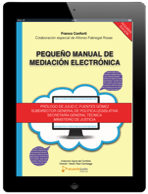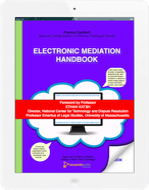Comentario del libro
(haga clic en el libro para comprarlo)
Extraído del Prólogo de la versión en Inglés: Este libro es una gran contribución a la literatura acerca de tecnología y resolución de disputas. Como el Profesor Conforti entiende, la frase "resolución de disputas online" (ODR) es un paraguas para muchas formas de resolución de disputas. Hay, sin embargo, también diferencias legales que se aplican a ciertas formas de resolución de disputas y no a otras formas. Este libro proporciona una guía clara sobre el contexto jurídico de la e-mediación.
Hay necesidad de libros como éste, que centran la atención en los detalles de ciertos tipos de procesos de resolución de conflictos. Este libro es, creo, el primero que se centra en la e-mediación.
Tiene en cuenta tanto la legislación Española como la Europea y forma en que afectan a la seguridad de la comunicación y la intimidad de las partes.
Ethan Katsh, Professor Emeritus of Legal Studies and Director National Center for Information Technology and Dispute Resolution, University of Massachusetts, Amherst.
Book comment
(clic on the imagen to buy)
This book is a welcome contribution to the literature about technology and dispute resolution. Technology is transforming the landscape of disputing. Even more than in the past, “conflict is a growth industry”1 as consumers have problems with transactions, citizens worry about their identity, businesses face threats to their reputations, social networks foster anti-social behaviour, governments struggle with security and everyone encounters poorly functioning Web sites. The merger of the physical world with the virtual world has brought with it a new range of transactions and relationships, many of them complex, novel and valuable. At the same time, as we become accustomed to Big Data, we are also finding bad data and along with more innovation often comes more bad design and more bad communication.
As Professor Conforti understands, the phrase online dispute resolution (ODR) is an umbrella for many different approaches to resolving disputes. All ODR processes share some common goals in that the communications systems employed need to be trusted and accessible. All ODR systems also share some challenges such as when choices need to be made between synchronous and asynchronous forms of communication. There are, however, also differences in that there are laws that apply to particular forms of dispute resolution and not to other forms. This book provides clear guidance about the legal context for e-mediation.
There is a need for books, such as this one, that focus attention on the details of particular kinds of online dispute resolution processes. This book is, I believe, the first to focus specifically on e-mediation. It takes into account both Spanish and European law and the manner in which they affect the security of communication and the privacy of the parties. It explains how digital signatures should be employed to build trust and insure the identities of the parties. Much of the writing on ODR from the United States neglects these topics, in that both offline and online mediation in the U.S. are informal and less subject to data protection and other types of European-based directives.
If one follows the guidance Professor Conforti’s provides in this book, our strategies for intervening in disputes will be greatly improved.
Ethan Katsh, Professor Emeritus of Legal Studies and Director National Center for Information Technology and Dispute Resolution, University of Massachusetts, Amherst.



